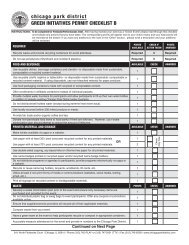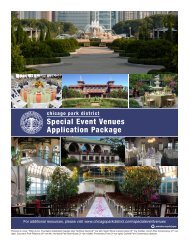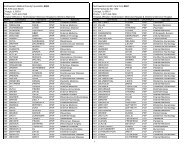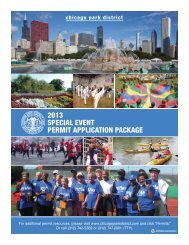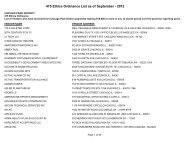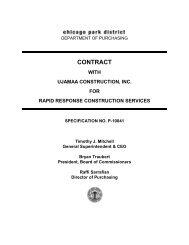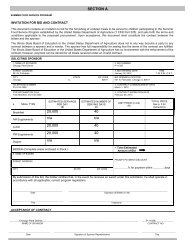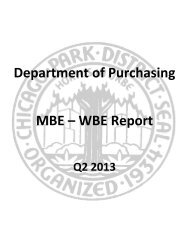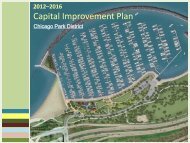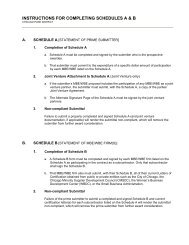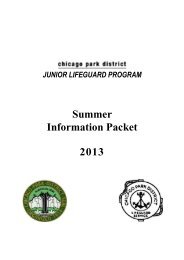2012 Budget Summary - Chicago Park District
2012 Budget Summary - Chicago Park District
2012 Budget Summary - Chicago Park District
- No tags were found...
Create successful ePaper yourself
Turn your PDF publications into a flip-book with our unique Google optimized e-Paper software.
Financial PoliciesThe <strong>District</strong> is also subjected to a separate statutory debt limit of 1% of EAV for certain generalobligation bonds issued without referendum. The <strong>District</strong> has in excess of $458 million incapacity under this limit. At the end of 2010, the <strong>District</strong> had approximately $934 million ofoutstanding long-term debt which is 16% more than the previous yearInvestment PolicyThe <strong>District</strong> invests public funds in a manner that is consistent with the all state and localstatutes governing the investment of public funds. Investments shall be undertaken in amanner that ensures the preservation of capital in the overall portfolio. The <strong>District</strong> shalldiversify its investments to avoid incurring unreasonable risks associated with specific securitiesand/or financial institutions. The investment portfolio must be sufficiently liquid to enable the<strong>District</strong> to meet all reasonable anticipated operating requirements and must be designed toobtain a market average rate of return during budgetary and economic cycles, taking intoaccount the <strong>District</strong>’s investment risk constraints and cash flow needs.Fund Balance PolicyFund balance is the difference between assets and liabilities reported in a fund at the end ofthe fiscal year. The <strong>District</strong> seeks to maintain adequate levels of fund balance to mitigatecurrent and future risks and to ensure stability. Fund balance is also a crucial consideration inlong-term financial planning. Credit rating agencies carefully monitor levels of fund balance andunreserved fund balances in the <strong>District</strong>’s General Fund to evaluate creditworthiness.Historically, the <strong>District</strong> has been able to maintain a healthy reserve through growthmanagement, strategic financial planning and constant cost analysis. It is the policy of the<strong>District</strong> to maintain certain levels of fund balance in the Long-Term Income Reserve Fund toprovide both specificity and flexibility, while accomplishing two main criteria:1. Target Level of Reserve - The reserve floor is set at $85,000,000.2. Specific Circumstances for Drawing Down Reserve – Due to the biannual nature of ourproperty tax collections, the <strong>District</strong> usually receives approximately half the tax levy in theSpring and the other half in the Fall. This often creates a cash deficit as our peak spending isduring the Summer months. Historically, the <strong>District</strong> would issue Tax Anticipation Warrantsto bridge the gap. Internal borrowings from the Reserve to the General Fund during theyear would be allowed for cash flow needs. The Reserve would be repaid as the nextinstallment of property tax revenue is received.Any other draw from the Reserve must be approved by the Board and should only be fornonrecurring expenditures or one-time capital costs and not ongoing operational typeexpenditures.35




